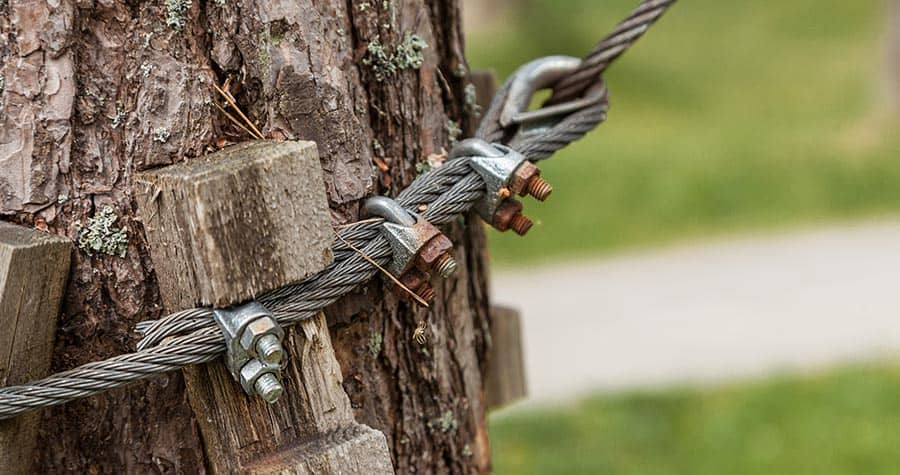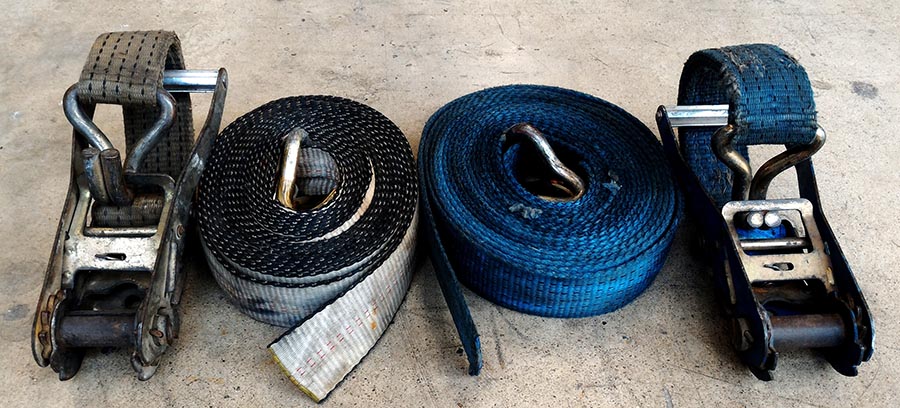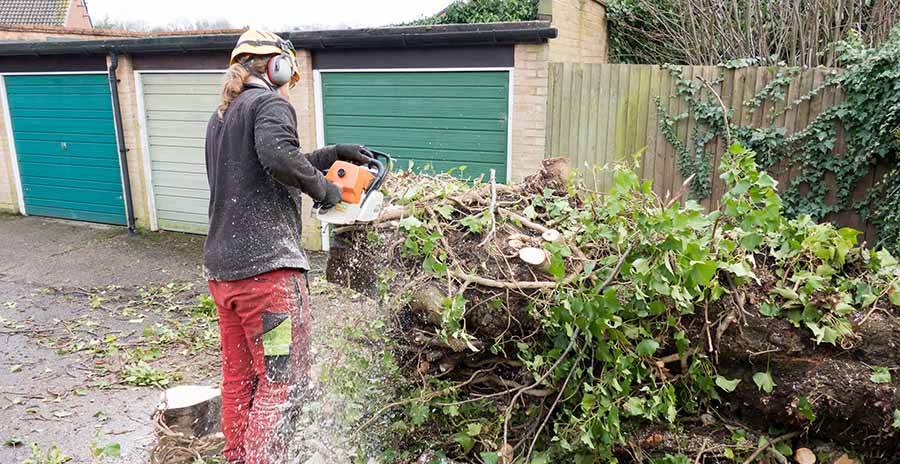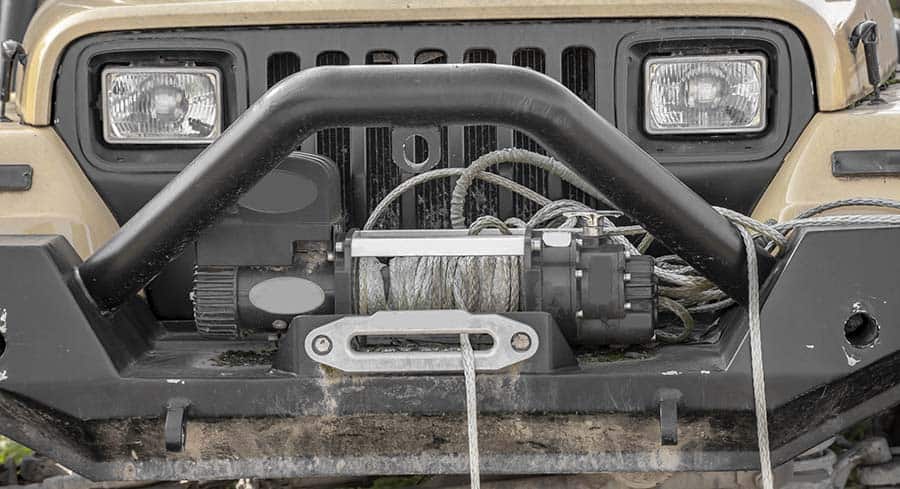Whether you’re trying to replant or remove a fallen tree, it can be quite a tedious task. Not only are there countless dangers involved, but it also requires a fair amount of heavy machinery (in most cases). However, there’s a handful of methods that you can try to quickly and efficiently lift a tree that’s knocked on its side.
The most effective ways to lift a fallen tree include digging out the soil and lifting it with a shovel, pulling it with guy cables, roping the tree with a sleeve, and using a garden hose. If you have access to more equipment, you can use a tractor, pallet jack, automotive winch, or timber jack.
Throughout this article, you’ll also learn the following information about how you can effectively lift a fallen tree:
- Various methods using basic gardening tools
- How you can incorporate multipurpose items, including pallet jacks and winches
- Different ways to easily dispose of the tree if it’s too far gone
Dig Out Soil and Push Back the Tree
If you’re dealing with a small tree, then using a shovel is sometimes the best method. You don’t need fancy equipment. Simply dig out a hole around the base of the trunk deep enough to wiggle the tree a bit.
Once the soil is loose, you can slowly push the tree back into place. Have someone keep an eye on the roots to ensure that they’re not being crushed. You might have to add fertilizer to enrich the soil for optimal root growth.
Moisturizing the soil can ensure that it accepts the roots easier. Rather than shoving them back into cracked, old soil, the roots will be able to push evenly back into place. Furthermore, it promotes better growth once the roots are established in a few weeks.
Note: Using a shovel is a bad idea if the roots are already brittle. A shovel can tear about the foundation of a tree, especially if it’s still youthful and growing. In these situations, you should be able to remove the excess soil with a trowel and prop it up by hand to pay close attention to detail.
Use Guy Cables to Anchor It Back

Another excellent method is to use guy cables and anchors. Guy cables are usually made out of a tough, finely-bound wire that’s designed to hold hundreds to thousands of pounds of force. Tie the guy cables around the top of the thickest part of the trunk to ensure a steady hold. Anything too low won’t allow for a proper lift.
Once you’ve secured the guy cables, consider removing excess dirt from the area. There’s a high chance that soil was thrown around when the tree fell, so try to check if there’s enough room for the roots to fall back into place. You could clear it out with a shovel and replace the soil once the tree is back up.
Feel free to tie the other end of the guy cables to the front of a vehicle, such as a truck, SUV, or tractor. Make sure that your vehicle is capable of towing the required amount of weight before you try this process.
Slowly pull it back into place, again checking to see if the roots are being crushed. Water the soil immediately to bring nutrition and hydration to the soil. As mentioned by Napa Valley Register, it’s a smart idea to keep the tree anchored for several weeks or months to stabilize it.
Tie a Rope with a Rubber Sleeve
Using a rope to lift a fallen tree is one of the oldest tricks in the book. Almost everyone has a rope, whether it’s densely woven paracord or made of various fibers. Whichever rope you choose, make sure it’s strong enough to handle the weight of the tree. Much like the first suggestion, this process only works for small trees.
Here’s how to do it:
- Start by wrapping a rubber sleeve around the portion of the tree that you’re going to use the rope. Even if you’re dealing with a slightly larger tree than normal, a sleeve can prevent damage to the park and internal fibers. You could also try thick blankets or pillows in a pinch.
- Wrap the rope around the sleeve or blanket, achieving a snug fit that won’t slide up or down. If it slides too much, you won’t be able to lift it. Ropes or paracords that snap in the middle of a lift can severely damage the tree. Use a double or triple knot to prevent this disaster from occurring.
- Tie the other end of the rope to a vehicle or pull it with a few helping hands. Depending on the size of the tree, you’ll need a lot of manpower to move it without the assistance of a motor.
Prop It Up with an Old Garden Hose
One of the smartest tricks from the Lawn Site community is to use an old garden hose to lift a fallen tree. While ropes are fairly common, everyone with a house has a garden hose. This trick will get you out of a bind when you’re dealing with a fallen tree.
Tie the rope around the middle to the top of the tree trunk. Since the rope is rubberized (or made of plastic), you don’t have to worry about using sleeves or blankets. Nonetheless, it doesn’t hurt to add the extra layer of protection for small, malleable trees.
Once the rope is secured, start pulling it out by hand. It might take between one to three people to get the job done. Keep in mind that you can’t use a vehicle since garden hoses aren’t always able to be tightened enough.
When the tree is propped up, have one to two people hold it while you add fresh soil, water, and anchors to prevent it from falling over again.
Push the Tree with a Tractor

Big trees require big solutions. Using a tractor is far from overdoing it if you have the option and the tree weighs a couple hundred pounds or more. If you don’t have access to a tractor, consider hiring a professional service to do the job for you. Never try to push out a fallen tree with a regular automobile.
Using a tractor to lift a fallen tree should go as follows:
- Clear roots, leaves, dirt, and other debris out of the space where the tree will stand.
- Choose to either push the tree vertically or pull it with a winch, rope, or another device.
- Once the tree is standing upright, remove broken branches to prevent clutter.
- Add more soil to the roots to secure the tree and bring it back to life.
- Use several anchors to prop the tree until the roots grow back.
If you’re trying to find good anchors, you can use wooden stakes, fence posts, metal pipes, and other stable, durable items. In a pinch, you can use several dozen tent stakes, but you’ll need to face them inward at a 45-degree angle to keep them from popping out or loosening the soil.
Attach Heavy-Duty Tie-Down Straps

Tie-down straps are some of the toughest security tools in the industry. You can use them to lift almost anything, as long as it’s within the recommended weight limit. Most people who live out in the country or own trucks have access to tie-down straps, but if you don’t, read on.
The AUGO Ratchet Tie-Down Straps that you can get on Amazon are designed to hold up to 1500 pounds without showing signs of wear and tear. Since most residential trees fall within this weight limit, you should be good to go. Each kit of these tie-down straps comes with four of them, allowing you to get multiple angles to lift and prop the tree.
Wrap the straps around the top portion of the trunk, then attach the other end of the straps to a vehicle or a jack. Tighten the straps by ratcheting them back and forth until they’re as snug as possible. The pack mentioned above also comes with a couple of bungee cords or four soft straps, depending on which set you choose. Use them to secure the anchors when the tree is lifted.
As always, when the tree is lifted, it’s time to use anchors, soil, and clear the debris from the area. Moisturize the soil and let the tree stand for a few days before checking on it again. Remember that high winds can push a loose tree over, so you might want to consider making a windbreak out of tarps or umbrellas.
Create a Pulley System for the Fallen Tree
Perhaps the most unique suggestion comes from the University of Florida, which suggests that you build a pulley system. This system is a bit complex, so you shouldn’t try this at home if you’re not mechanically inclined. It also requires a bit of land, making it useless for small yards.
Here’s how you can make a pulley system to lift a tree:
- Purchase three or four 4” x 4” wooden posts. Hickory tends to be the toughest wood, but it’s not always readily available. In this case, oak or a similar type of wood will do just fine. The posts should be about 6’ tall, and you’ll also need a durable 10’ rope for each of the posts.
- Attach the ropes to the top of each wooden post, then hammer the posts into the ground at a 45-degree angle with the tops facing outward (away from the tree). Tie each rope around the top of the tree, attempting to overlap them as much as possible.
- Slowly pull the posts back away from the tree. Note that you’ll need one person at each post to ensure the it’s being lifted evenly. It’ll take a few minutes since you’re relying on the strength of the pullers and the toughness of the wood and ropes.
Cut the Tree with a Saw

If the tree isn’t able to be saved or you want to remove it, then it’s time to chop it apart. This process is fairly simple since it says it in the title. However, there’s room for mistakes, so we’ll cover a plethora of useful tips to make it easier for you.
Here’s what you should know before you chop and toss a fallen tree:
- Always start by cutting apart the small twigs, branches, and leaves to get the clutter out of the way. They might seem unimportant, but you’ll significantly reduce the weight of the tree by doing it.
- Chop the fallen tree into two to three-foot sections. Never try to bite off more than you can chew. Wood Web shows that a small portion of a 16-inch wide tree can weigh hundreds of pounds.
- Grind the logs or use them as firewood when you’re done. There’s no point in tossing old wood. Dice the roots apart and toss them in the firepit or compost them to use as an all-natural fertilizer.
- Fill the hole where the tree was with ground bits of the tree, twigs, branches, leaves, and soil. Using only loose dirt will cause sinkholes that dip into your yard. You could also consider filling the hole with rocks, topping it off with soil and grass for a better appearance.
Use Chemicals to Disintegrate the Tree
As mentioned by SF Gate, there are chemicals that can be used to dissolve small portions of trees. If you want to get rid of the trunk without using it for firewood or throwing it away, then chemicals are the way to go. Before you get started, make sure it’s legal to dissolve trees in your area.
All you have to do is get a granular herbicide, drill holes in the log, and fill it with the herbicide. Let it sit for a few days and watch as it breaks down naturally. To speed the process along, use a garden hose to hydrate the granules. The chemical process starts when they get watered, which is how the wood can dissolve so quickly.
The best chemical herbicide to use is potassium nitrate. The holes should be about 12 inches deep to ensure that they reach the core of the wood. Consider making a variety of holes with different depths to cover all parts of the tree.
Note: Use caution when dissolving a tree with chemicals. Always wear protective goggles, gloves, and long-sleeve clothing to prevent unwanted injuries.
Prop It with a Pallet Jack
Tree Buzz offers a helpful suggestion to use a pallet jack to lift a fallen tree. All you have to do is slide the jack under the tree with a leg on either side of the trunk. Slowly prop the tree with the jack, sliding both legs under the tree as you move along. The jack should be perpendicular to the tree.
Since most pallet jacks only go so high, you’ll need to use something else to lift the log eventually. If you’re disposing of the tree, then you can use the jack to transport it from one place to another easily. However, you’ll need ropes or guy cables to finish the lifting process if you want to preserve and replant the tree.
Pull It Out with an Automotive Winch

Automotive winches are some of the toughest tools that we have at our disposal. If you want to pull a medium-sized tree off of the ground, then a winch will do the job without a problem. Before you get started, ensure that your winch has enough capacity to lift the tree and your vehicle can handle the load.
Here’s how you can use an automotive winch to lift a fallen tree:
- Attach the winch to your vehicle and the tree trunk. Ensure that it’s tightened on both sides to prevent injuries or dropping the tree. You might have to use a couple of ropes to wrap the tree for better security, depending on the width of the winch cable.
- Use the remote provided with the winch to pull it back. Unlike when you normally set the vehicle in neutral to remove it from the mud or snow, you should set it in reverse. Tighten the winch with the remote, then back the vehicle slowly.
- When the tree stands upright, follow the aforementioned steps suggested throughout this post; Moisturize the soil, clear the area of debris, and use anchors for better security.
Conclusion
Fallen trees are frustrating to deal with, but you can use these 11 effective methods to get them out of the way or back to where they belong.
Here’s a quick breakdown of the post:
- You can use simple tools, including ropes, shovels, and pallet jacks, to prop a tree.
- Always anchor the tree to allow the roots to get established.
- Moisturized the soil and add fertilizer when it’s upright again.
- Consider heavy machinery, such as automotive winches or tractors, so get the job done.
- You can dispose of a large tree by chopping it or using chemicals.

